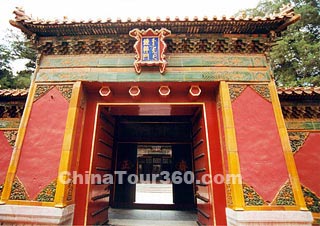 |
| Gate of Purity, Six Eastern Palaces |
Six Eastern Palaces is situated on Dongyichang Street on the east side of the central axis of the Forbidden City. It is an architectural complex composed of 6 yards built in the same style. The six palaces are Palace of Great Benevolence (Jingrengong), Palace of Accumulated Purity (Zhongcuigong), Palace of Celestial Favor (Chengqiangong), Palace of Great Brilliance (Jingyanggong), Palace of Eternal Harmony(Yonghegong) and Palace of Prolonging Happiness (Yanxigong). These palaces each have a square shape of 50 meters (54.7 yards) on each side, with one principal room, two wing rooms, and two courtyards respectively.
Palace of Great Benevolence was the living place of the emperor’s concubines in the Ming Dynasty (1368 - 1644). The noted Emperor Qianlong of the Qing Dynasty (1644 - 1911) was born in this palace. Now it is an exhibition hall for exhibiting the donated cultural relics and shows gratitude and respect to the donors.
Palace of Accumulated Purity was the living space for the crown prince in the Ming Dynasty (1368 - 1644). Now it has been developed to be a special hall for displaying ancient jade articles.
Built in 1420, Palace of Celestial Favor was the living place of the emperor’s concubines in the Ming and Qing dynasties. Now it is an exhibition hall for ancient Chinese bronze wares.
Palace of Great Brilliance was also the dwelling for the imperial concubines in the Ming Dynasty. It was used for storing books after the renovation in 1686. At present it still keeps its initial setup dating from the Ming Dynasty, but is used as an exhibition hall for ancient golden and silver objects.
Palace of Eternal Harmony was also living place for the emperor’s wives in the Ming and Qing dynasties. It is now an exhibition room for bronze mirrors in previous ages.
Palace of Prolonging Happiness is a nondescript unfinished western building in the Forbidden City. Originally, it had a same structure as the other five palaces of the Six Eastern Palaces. In 1845, this Palace of Prolonging Happiness was burnt down. No re-construction or renovation was undertaken until 1909, when Empress Duankang had a three-story western-style building constructed on the original site. However, construction was halted halfway through because of financial problems. In 1917, the northern part of the Palace of Prolonging Happiness was ruined by bombs. In 1931, a storehouse for cultural relics was built on the ruins by the Palace Museum. Today it serves as an exhibition room for porcelain wares made by the Guan Kiln of the Song Dynasty (960 - 1279).
Besides the six palaces, there are Hall of Abstinence (Zhaigong) and Hall for Ancestral Worship (Fengxiandian) in the Six Eastern Palaces area. The Hall of Abstinence was the place for the emperors’ abstinence before holding a sacrificial ceremony to worship heaven. From the Ming dynasty to the early Qing Dynasty, the abstinence was always held outside of the imperial palace. After Emperor Yongzheng ascended to the throne, he decided to hold the abstinence in the palace, so the Hall of Abstinence was specially built for this purpose. The Hall for Ancestral Worship was the ancestral temple of the royal family in the Ming and Qing dynasties. The emperors would hold a ceremony to worship their ancestors in the front hall of the Hall for Ancestral Worship on the occasion of every New Year, Winter Solstice, birthday of the emperor, and other festivals and celebrations. Also the emperors would burn incense to worship the god in the back hall during Tomb-sweeping Day, Lantern Festival and death days of the former emperors or empresses.
Today the Hall for Ancestral Worship is an exhibition hall for clocks and watches. There are over 200 clocks and watches of all styles made in China and foreign countries in the 18th century on display here. All of the exhibitions were carefully selected. There is a clock and watch demonstration each day at 11:00 and 14:00 in the hall so that tourists will have a better appreciation about how the various clocks and watches function.
Making a visit to the Six Eastern Palaces, visitors can not only enjoy the living places of the crown princes and the emperors’ concubines, but they can also feast their eyes on various exhibitions, such as jade objects, golden and silver wares, bronze wares, bronze mirrors, clocks and watches.
![]() Go to the Next Attractions: Nine-Dragon Screen & Hall of Imperial Supremacy
Go to the Next Attractions: Nine-Dragon Screen & Hall of Imperial Supremacy








